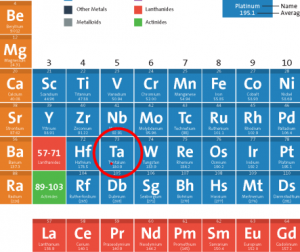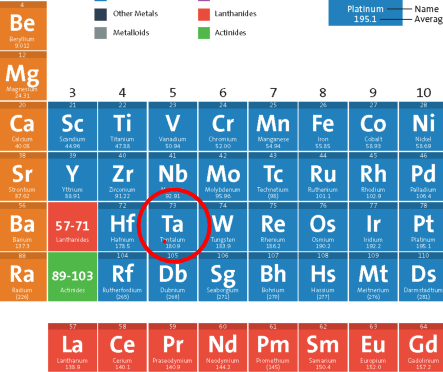
ASTM B364 Standard Specification for Tantalum and Tantalum Alloy Ingots
| Compositions | Preparation Methods | |
| R05200 | Unalloyed tantalum | Electron-beam furnace or vacuum-arc melt, or both |
| R05400 | Unalloyed tantalum | Powder-metallurgy consolidation |
| R05255 | 90 % tantalum, 10 % tungsten | Electron-beam furnace or vacuum-arc melt, or both |
| R05252 | 97.5 % tantalum, 2.5 % tungsten | Electron-beam furnace or vacuum-arc melt, or both |
| R05240 | 60 % tantalum, 40 % columbium | Electron-beam furnace or vacuum-arc melt, or both |
Notes:
All Tantalum and Tantalum Alloy Ingots must adhere to specified limits for the following chemical elements: carbon, oxygen, nitrogen, hydrogen, niobium, iron, titanium, tungsten, molybdenum, silicon, nickel, and tantalum.
ASTM B365 Standard Specification for Tantalum and Tantalum Alloy Rod and Wire
–Chemical Compositions
| Compositions | Preparation Methods | |
| R05200 | Unalloyed tantalum | Electron-beam furnace or vacuum-arc melt, or both |
| R05400 | Unalloyed tantalum | Powder-metallurgy consolidation |
| R05255 | 90 % tantalum, 10 % tungsten | Electron-beam furnace or vacuum-arc melt, or both |
| R05252 | 97.5 % tantalum, 2.5 % tungsten | Electron-beam furnace or vacuum-arc melt, or both |
| R05240 | 60 % tantalum, 40 % columbium | Electron-beam furnace or vacuum-arc melt, or both |
Notes:
All Tantalum and Tantalum Alloy Rods and Wires must adhere to specified limits for the following chemical elements: carbon, oxygen, nitrogen, hydrogen, niobium, iron, titanium, tungsten, molybdenum, silicon, nickel, and tantalum.
–Dimensions Tolerance
| Diameter | Dimensions Tolerance,± |
| 0.010to0.020in.excl 0.254to0.508mm | 0.0005in./ 0.013mm |
| 0.020to0.030in.excl 0.508to0.762mm | 0.00075in./ 0.019mm |
| 0.030to0.060in.excl 0.762to1.524mm | 0.001in./ 0.025mm |
| 0.060to0.090in.excl 1.524to2.286mm | 0.0015in./ 0.038mm |
| 0.090to0.125in.excl 2.286to3.175mm | 0.002in./ 0.051mm |
| 0.125to0.187in.excl 3.175to4.750mm | 0.003in./ 0.076mm |
| 0.187to0.375in.excl 4.750to9.525mm | 0.004in./ 0.102mm |
| 0.375to0.500in.excl 9.525to12.70mm | 0.005in./ 0.127mm |
| 0.500to0.625in.excl 12.70to15.88mm | 0.007in./ 0.178mm |
| 0.625to0.750in.excl 15.88to19.05mm | 0.008in./ 0.203mm |
| 0.750to1.000in.excl 19.05to25.40mm | 0.010in./ 0.254mm |
| 1.000to1.500in.excl 25.40to38.10mm | 0.015in./ 0.381mm |
| 1.500to2.000in.excl 38.10to50.80mm | 0.020in./ 0.508mm |
| 2.000to2.500in. excl 50.80to63.50mm | 0.030in./ 0.762mm |
ASTM B708 Standard Specification for Tantalum and Tantalum Alloy Plate, Sheet, and Strip
–Chemical Compositions
| Compositions | Preparation Methods | |
| R05200 | Unalloyed tantalum | Electron-beam furnace or vacuum-arc melt, or both |
| R05400 | Unalloyed tantalum | Powder-metallurgy consolidation |
| R05255 | 90 % tantalum, 10 % tungsten | Electron-beam furnace or vacuum-arc melt, or both |
| R05252 | 97.5 % tantalum, 2.5 % tungsten | Electron-beam furnace or vacuum-arc melt, or both |
| R05240 | 60 % tantalum, 40 % columbium | Electron-beam furnace or vacuum-arc melt, or both |
Notes:
All Tantalum and Tantalum Alloy Plates, Sheets, and Strips must adhere to specified limits for the following chemical elements: carbon, oxygen, nitrogen, hydrogen, niobium, iron, titanium, tungsten, molybdenum, silicon, nickel, and tantalum.
–Dimensions Tolerance
| Thickness | Dimensions Tolerance | |
| Width under 6in./ 152.4mm | Width 6 to 24in./
152.4 to 609.6mm |
|
| 0.0051to0.010 in./ 0.129to0.254mm | 0.126to0.187 in./ 3.200to4.750mm | |
| 0.0051to0.010 in./ 0.129to0.254mm | 0.0007in./ 0.0178mm | 0.001in./ 0.0254mm |
| 0.016to0.020 in./ 0.406to0.508mm | 0.0008in./ 0.0203mm | 0.0015in./ 0.0381mm |
| 0.021to0.030 in./ 0.533to0.762mm | 0.0015in./ 0.0381mm | 0.0025in./ 0.0635mm |
| 0.031to0.060 in./ 0.787to1.524mm | 0.0025in./ 0.0635mm | 0.0035in./ 0.0889mm |
| 0.061to0.090 in./ 1.549to2.286mm | 0.004in./ 0.1016mm | 0.005in./ 0.1270mm |
| 0.091to0.125 in./ 2.311to3.175mm | 0.006in./ 0.1524mm | 0.007in./ 0.1778mm |
| 0.126to0.187 in./ 3.200to4.750mm | 0.010in./ 0.2540mm | 0.010in./ 0.2540mm |
| Width | Dimensions Tolerance | |
| Width under 6in./ 152.4mm | Width 6 to 24in./
152.4 to 609.6mm |
|
| 0.0051to0.010 in./ 0.129to0.254mm | 0.012in./ 0.305mm | |
| 0.0051to0.010 in./ 0.129to0.254mm | 0.0015in./ 0.0381mm | 0.015in./ 0.381mm |
| 0.016to0.020 in./ 0.406to0.508mm | 0.0015in./ 0.0381mm | 0.0015in./ 0.0381mm |
| 0.021to0.030 in./ 0.533to0.762mm | 0.020in./ 0.508mm | 0.025in./ 0.635mm |
| 0.031to0.060 in./ 0.787to1.524mm | 0.025in./ 0.635mm | 0.030in./ 0.762mm |
| 0.061to0.090 in./ 1.549to2.286mm | 0.025in./ 0.635mm | 0.035in./ 0.889mm |
| 0.091to0.125 in./ 2.311to3.175mm | … | … |
| 0.126to0.187 in./ 3.200to4.750mm | … | … |
| Sheared Lengths | Dimensions Tolerance | |||
| Length 12in./
304.8 mm and Under |
Length over 12in./
304.8 mm |
|||
| Plus | Minus | Plus | Minus | |
| 0.0051to0.010 in./ 0.129to0.254mm | 1⁄16 in./ 1.59mm | 0 | 1⁄4 in./ 6.35mm | 0 |
| 0.0051to0.010 in./ 0.129to0.254mm | 1⁄16 in./ 1.59mm | 0 | 1⁄4 in./ 6.35mm | 0 |
| 0.016to0.020 in./ 0.406to0.508mm | 1⁄16 in./ 1.59mm | 0 | 1⁄4 in./ 6.35mm | 0 |
| 0.021to0.030 in./ 0.533to0.762mm | 1⁄16 in./ 1.59mm | 0 | 1⁄4 in./ 6.35mm | 0 |
| 0.031to0.060 in./ 0.787to1.524mm | 1⁄16 in./ 1.59mm | 0 | 1⁄4 in./ 6.35mm | 0 |
| 0.061to0.090 in./ 1.549to2.286mm | 1⁄16 in./ 1.59mm | 0 | 1⁄4 in./ 6.35mm | 0 |
| 0.091to0.125 in./ 2.311to3.175mm | 1⁄16 in./ 1.59mm | 0 | 1⁄4 in./ 6.35mm | 0 |
| 0.126to0.187 in./ 3.200to4.750mm | 1⁄16 in./ 1.59mm | 0 | 1⁄4 in./ 6.35mm | 0 |
ASTM B521 Standard Specification for Tantalum and Tantalum Alloy Seamless and Welded Tubes
–Chemical Compositions
| Compositions | Preparation Methods | |
| R05200 | Unalloyed tantalum | Vacuum melted |
| R05400 | Unalloyed tantalum | Powder-metallurgy consolidation |
| R05255 | 90 % tantalum, 10 % tungsten | Vacuum melted |
| R05252 | 97.5 % tantalum, 2.5 % tungsten | Vacuum melted |
| R05240 | 60 % tantalum, 40 % columbium | Electron-beam furnace or vacuum-arc melt, or both |
–Dimensions Tolerance
| Outside Diameter | Diameter Tolerance | Permissible Variations
in Wall Thickness |
| Under1in.
25.4mm,excl |
0.004in./ 0.102mm | 10% |
| 1 to 1-1/2in.
25.4to38.1mm,excl |
0.005in./ 0.127mm | 10% |
| 1-1/2 to 2in.
38.1to50.8mm,excl |
0.006in./ 0.152mm | 10% |
| 2 to 2-1/2in.
50.8to63.5mm,excl |
0.007in./ 0.178mm | 10% |
| 2-1/2 to 3-1/2in.
63.5to88.9mm,excl |
0.010in./ 0.254mm | 10% |
ASTM Standard Specification for Tantalum and Tantalum Alloy: FAQs
1. What Is An ASTM Standard Specification?
– An ASTM Standard Specification is a document that sets forth guidelines, requirements, and characteristics for various materials, products, systems, and services, ensuring their quality, consistency, and safety. These standards are essential in many industries for ensuring product reliability and safety.
2. Why Are ASTM Standards Important in Industries?
– ASTM standards are crucial for industries to maintain the quality, safety, and reliability of their products and materials. They are often required for procurement, manufacturing, and regulatory compliance. These standards are recognized globally, aiding in international standardization.
3. What Does This Specific ASTM Standard Cover?
– This ASTM standard covers specifications for tantalum and tantalum alloy products, including ingots, rods, wires, tubes, plates, sheets, and strips. It categorizes materials into types like unalloyed tantalum (R05200mm), powder-metallurgy consolidated tantalum (R05400mm), and various tantalum alloys.
4. What Are the Key Features of Tantalum Materials as per the ASTM Standard?
– The standard specifies limits for elements like carbon, oxygen, nitrogen, hydrogen, and others in tantalum materials. It outlines preparation methods such as vacuum-arc melting and electron-beam melting. The standard may also specify the alpha plus beta condition to enhance mechanical properties for specific applications.
5. How Is the Alpha Plus Beta Condition Relevant in Tantalum Alloys?
– The alpha plus beta condition, specified in some ASTM standards, is a metallurgical state that enhances the mechanical properties of metal alloys, making them suitable for specialized applications such as surgical implants.
